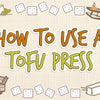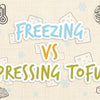15 Popular Types of Tofu | Every Variety Included
There are many types of tofu, all suited to different dishes. Tofu is a traditional East Asian and South East Asian cuisine that is prepared by coagulating soy milk which is then pressed into tofu. Tofu has been consumed for over 2000 years in parts of China before it later spread into the rest of the western world.
Tofu has a subtle flavor making it the perfect addition to any savory and sweet dishes. It is often seasoned to suit the specific flavors. This is because it absorbs flavors well and is incredibly versatile.
Not Much Time? Skip To What You'd Like To Learn...
Why Is Tofu Popular?

When it comes to nutritional count, tofu is considered to be a healthy source of protein as it has a relatively large amount while containing low amounts of calories. It is also rich in iron, calcium, and magnesium depending on the coagulants used in the manufacturing process.
Which Is The Best Tofu to Buy?

There are many tofu varieties ranging from extra firm, firm, soft, silken. This makes picking the right one quite a daunting task. The type of variety to use will depend on the dish you are making. Another factor to consider is that the firmer tofu options contain a lower moisture content and are richer in protein.
15 Types
1. Silken Tofu

Best Cooked: Blended into sauces
Texture: Soft
Our Favorite Recipe: Vegan Chocolate Banana Pudding
Additional Information: The silken soft tofu variant is originally from Japan. It has a soft texture that is almost that of panna cotta. This is because silken tofu contains more water and as a result, fewer nutrients.
The production process eliminates the typical soybean flavor that is disliked by some. Unlike other types which are often pressed during production, silken tofu is left unpressed therefore retaining all its moisture.
This variety has a creamy feel and fatty flavor that’s as a result of making it with denser soya milk. However, over time, the tofu may develop a faint sour taste. In terms of texture, the silken tofu can be described as pudding-like. It's also very soft and smooth to cut through.
Silken tofu is great as a dairy or cream alternative in sauces or desserts. It can also be served with broccoli, noodles, or rice. Silken tofu is mainly sold as a canned food product and once opened the food can be refrigerated in a jar for up to 2 weeks.
Image by @marystestkitchen
2. Regular Tofu

Best Cooked: Scrambled
Texture: Smooth
Our Favorite Recipe: Tofu Escalopes with Black Olive Salsa Verde
Additional Information: Regular tofu is characterized by a soft consistency, firm but easy to cut into. This variety is also referred to as Chinese-style tofu due to its preparation method. Regular tofu has a higher moisture content, compared to super firm tofu. As a result, it cannot be deep-fried as it will crumble.
In terms of taste, regular tofu’s taste is dependant on the seasonings added. Regular tofu has a compact interior that readily soaks up sauces and flavors, making it perfect for broth and noodle soups with stews. The lower moisture also makes it super easy to cut the tofu into bite sized cubes. Once cooked regular tofu can have a crispy texture on the outside and a somewhat custardy texture on the interior, some regular tofu varieties can also end up puffed up like doughnuts. It can also be served raw with toppings such as azuki beans, oatmeal, mung beans, and boiled peanuts.
Image by @thekindsage
3. Firm Tofu

Best Cooked: Pan fried
Texture: Firm and springy
Our Favorite Recipe: Pan Fried Tofu
Additional Information: It undergoes extended pressing to reduce the moisture content As a result, the tofu is often sold as firm blocks with the skin exhibiting patterns of the muslin that is used to drain and press the tofu. It is often sold as unflavored and has a rubbery feel close to that of paneer. This variety has the firmness of raw meat and will spring back if pressed.
Before cooking, the large block is often sliced into cubes or triangles, it's also possible to slice it into extra-thin slices which can be crumbled. Due to its firmness, it can be stir-fried, deep-fried, or even pan-fried. This allows it to be incorporated in just about any other meal and it’s an excellent replacement for meat. It especially goes well with chili soy dipping and other specialty meals.
Image by @pueyloo
4. Super Firm Tofu

Best Cooked: Baked
Texture: Firm and rubbery
Our Favorite Recipe: Asian Garlic Tofu
Additional Information: This type is characterized by a firm somewhat rubbery texture. This is achieved by pressing the soy curd until most of the moisture has been removed. This drastically increases the amount of amino acids, minerals, and calories. This makes it a great alternative to meat-based sources of proteins.
Super firm tofu has a bland flavor, but some East Asia varieties may have more of a beany flavor. This difference arises depending on the type of grind used in the preparation process. Whereby, the hot grind method inactivates lipoxygenase enzyme, which is the protein molecule responsible for generating the beany flavors. In the cold grind process; however, the lipoxygenase molecule remains active and produces volatile ester compounds which create the beany notes.
Super firm tofu goes well with sesame peanut sauce. Due to its dense texture, this variety is best baked until its golden brown with slightly crisp edges and a chewy center. However, there are other recipes which include frying, deep-frying, grilling, and barbequing.
Image by @vegtv
5. Extra-Firm Tofu

Best Cooked: Garnished and fried
Texture: Non-crumbly with a rubbery feel
Our Favorite Recipe: Crunchy Tofu
Additional Information: Extra-firm tofu differs in terms of the density and moisture content. Whereby extra firm tofu is much denser due to the rigorous pressing that eliminates most of the moisture content. The resulting bean curd is often white in color with solid edges and a texture bordering that of cooked meat.
Extra-firm tofu usually crumbles relatively easily when sliced thinly. When cut into cubes and triangles it can be stir-fried, deep-fried, or pan-fried until it develops a golden-brown hue. However, it does not absorb marinades as well as firm tofu. It can be served with sauces and served with dishes such as rice and vegetables. The tofu can also be coated with corn starch to preserve the flavor.
The high amount of proteins found along with reduced carb count makes it a perfect addition to any other meal.
Image by @nourishing_emma
6. Smoked Tofu

Best Cooked: Grilled
Texture: Crispy with a chewy interior
Our Favorite Recipe: Smoked Tofu Goulash
Additional Information: This type might as well be the vegetarian smoky bacon. This meal is prepared by smoking firm tofu until it is evenly cooked. While it is available in most grocery stores, you can make your own by smoking it with beechwood or any other smoky flavor. It's recommended to use olive oil while frying smoked tofu for that perfectly crispy skin, it is also a much healthier choice.
It can be served with just about any food. Stir fried and served with eggs, it can also be eaten as smoked tofu goulash, a dish that also incorporates sweet potatoes, smoked paprika, and lots of peppers. As well as the obvious smoky flavor, the tofu can be seasoned to taste using lemon juice, pepper, and salt.
Image by @gavt73
7. Seasoned Tofu

Best Cooked: Marinated
Texture: Depends on the seasoning used
Our Favorite Recipe: Nasi Goreng
Additional Information: Because tofu has a bland taste, there’s no limit in terms of just how you can season it. As a result, some of the dried tofu is usually pre-seasoned with specified blends of spices. This trend originated from China where the tofu may either be 'five-spice tofu' or 'soy sauce stewed tofu'.
It is mostly packed as either sliced thinly or cubed and ready to cook. Some of the most popular seasoning blends include soy sauce, hot pepper, and salt. While you can add more seasoning to this variety, it's recommended to use measured amounts to avoid spoiling the exquisite flavor. Saltless variations also do exist.
The texture usually takes after the specific seasoning used. It is common practice to marinade the seasoned tofu and other ingredients in a fridge for a more intense flavor.
It goes down well with tropical dishes and should be served with a side helping of vegetables.
Image by @babykat1
8. Fermented Tofu

Best Cooked: Stir fried
Texture: Soft and spreadable texture
Our Favorite Recipe: Cauliflower Stir Fry
Additional Information: Fermented tofu, also known as fermented bean curd, is a salty condiment from the Chinese cuisine. Its preparation involves fermenting bean curd in salt brine; this was initially for preservation purposes.
The condiment has a salty and savory taste with a soft and spreadable texture resembling that of certain cheeses. Fermented tofu can be enjoyed as an ingredient in a dipping sauce, or braising sauce for pork spare ribs. The dish can also be used in stir-fried dishes and steamed ones too.
Fermented tofu is usually packed in jars and cans, therefore, can be stored in the fridge for up to 6 months. Avoid spilling the brine as it helps in the preservation of the tofu.
Image by @chloe_hamtaro
9. Tofu Puffs

Best Cooked: Deep fried
Texture: Light and spongy
Our Favorite Recipe: Deep Fried Puffs
Additional Information: They are prepared by deep frying bean curd. The curd is usually pressed flat and cut into small rectangular shapes. These are then deep-fried until they form a golden-brown hue on both sides. The interior often puffs outwards giving the puffs a squishy texture that’s light instead of crisp.
Commercially cooked tofu balls will have hollow centers and are usually packed in airtight containers and can be refrigerated up to the expiry date. However, once unsealed, they will absorb moisture from the air and should, therefore, be consumed within three days.
The preparation process relies on tofu that’s been freshly pressed. If you are unable to purchase pre-cooked tofu puffs, you can prepare them in your kitchen but ensure that you use fresh firm tofu to attain light and spongy texture with a delicious taste.
These can be enjoyed with just about any marinade or sauce. The chewy but absorbent texture makes it perfect for soaking up flavors. The hollow centers can also be stuffed with rice.
Image by @solomon_leigh
10. Fried Tofu

Best Cooked: Fried
Texture: Soft and spongy
Our Favorite Recipe: Abura-age Tofu
Additional Information: The culture of frying tofu has its roots in Japanese cuisine. There are two distinctive varieties. The Abura-age fried tofu comprises oblong slices that are further cut into strings and served over rice or in soups, it is also stuffed with noodles and capped with surimi to form the famous Taiwan dish called A-gei. The sushi-age refers to small squares that are filled with sushi rice and served as sushi.
Other variations do exist, such as the Chinese bean bubble with a crispy and custardy texture. Due to its soft texture when soaked, firm tofu is best recommended for the preparation of fried tofu.
The main difference between fried tofu and deep-fried tofu is usually the moisture content. Deep-fried tofu has a much lower moisture content compared to fried tofu which has a higher moisture content, this allows it to be worked into various shapes before frying.
It can be eaten on its own or with spicy sauce served with rice. They are also sold under the name tofu pockets which require tofu that has been placed in boiling water for a few minutes and then patted and dried before cutting like an envelope.
Image by @oo_my_food_memories_oo
11. Tofu Sticks

Best Cooked: Baked
Texture: Crispy and crunchy
Our Favorite Recipe: Crispy Tofu Sticks
Additional Information: Traditionally tofu sticks were made by sun-drying rolled tofu skins and then cutting them into thin stick sized slices. Commercially available tofu sticks are usually pre-seasoned and pre-cooked.
You can also prepare this delicious snack in your own kitchen. Such a recipe would require super firm tofu which has already been drained and pressed followed by slicing into 1-inch thick slices. These are then coated in flour, eggs, and cornflakes before baking.
Due to the crispy and crunchy nature of tofu sticks, they can be served as either a snack or side dish. Spicy tofu sticks go down well with beef and Sichuan peppercorn, or coconut and lemongrass salad.
Image by @morganeatston
12. Tofu Skin

Best Cooked: Braised
Texture: Soft yet rubbery
Our Favorite Recipe: Yuba
Additional Information: This forms on the surface of soya milk when heated. This is done in open shallow pans to produce a skin or film composed majorly of soy protein lipids and carbohydrates. The skin is usually yellowish and can be dried to prolong its shelf life.
They have a soft and rubbery texture that are easy to fold into shapes. This makes them perfect for pan-frying and filling as well as deep-frying, just like spring rolls. They can also be used to make dim sum, a Chinese cuisine that involves serving food in small steamer baskets. Tofu skins are also perfect for red braising pork shoulder, and a stock consisting of soy sauce, wine, and sugar. In terms of seasoning, you can go with cinnamon, star anise, and cloves.
Image by @immi.sf
13. Pickled Tofu

Best Cooked: Raw with salads
Texture: Soft
Our Favorite Recipe: Tofu Pickles
Additional Information: Pickled tofu refers to cubes of dried extra firm tofu that have been aired out to reduce the moisture content. These are then soaked in brine, vinegar, or Chinese wine. This effectively ferments the tofu preserving it for future use.
One of the most common varieties of pickled tofu is the Chinese red pickled tofu which relies on red yeast rice for added color. The pickling gives the tofu a deep savory flavor, also called umami. As a result, fermented tofu is used as a flavoring instead of an ingredient.
This side dish can be consumed with noodles or rice, as well as served with salads. It can also be served with a drizzle of sesame oil.
Image by @cleanfuture_veganlife
14. Stinky Tofu

Best Cooked: Deep fried
Texture: Soft but crispy when fried
Our Favorite Recipe: Fried Stinky Tofu
Additional Information: Stinky tofu, also known as Pinyin, is soft Chinese tofu that has undergone fermentation in a fish and vegetable brine. The resulting blocks of tofu have a distinctively pungent cheese-like smell almost like rotting food. This smell makes it less prevalent in the USA.
When it comes to cooking, stinky tofu’s soft texture is great for mixing with soy sauce or sweet sauce. Stinky tofu can be deep-fried and accompanied by chili sauce. It also goes down well with pork and boiled vegetables.
Image by @cookingwithmamamui
15. Thousand-Layer Tofu

Best Cooked: Deep fried
Texture: Springy and gummy
Our Favorite Recipe: Thousand Layer Tofu
Additional Information: The thousand-layer tofu is a Chinese frozen tofu variety. The preparation process relies on soft tofu, which has a higher moisture content.
During the freezing process ice crystals form resulting in the formation of large cavities. These tiny holes are especially great for absorbing sauces and soups. After dry freezing, the thousand-layer tofu ends up as a firm and crumbly tofu with a springy texture.
Image by @charisewoo







